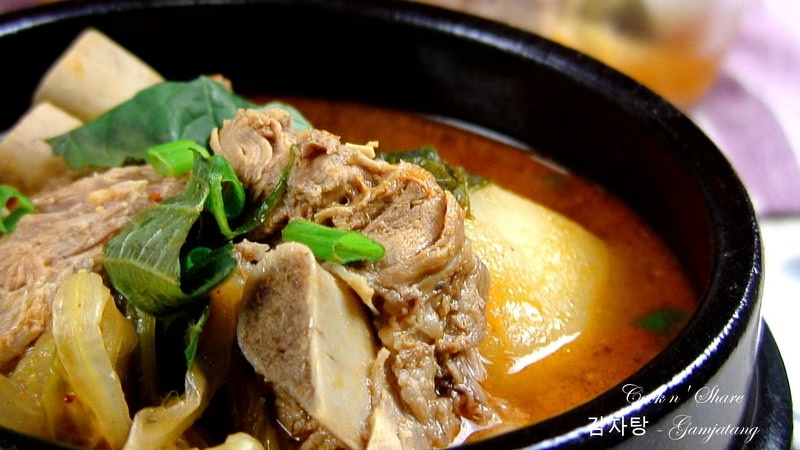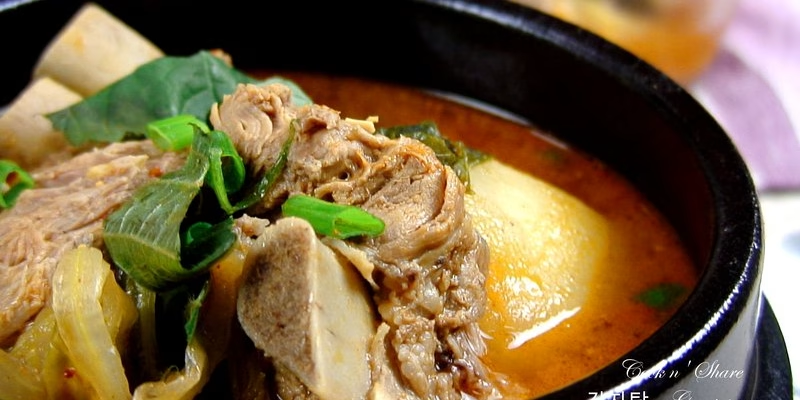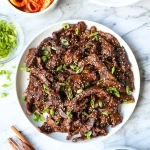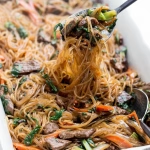
Introduction
Gamjatang (Pork Bone Soup) is not just a dish; it’s a heartwarming experience! Originating from Korea, this rich and nourishing soup is a beloved comfort food that many enjoy, especially during chilly days or when feeling under the weather. Its unique flavor profile, featuring savory pork bones and a medley of vibrant vegetables, sets it apart from other soups.
In this article, we’ll dive into the delightful world of Gamjatang (Pork Bone Soup), exploring the essential *Gamjatang (Pork Bone Soup) ingredients*, techniques to create the perfect broth, and variations that can suit anyone’s palate. Whether you’re looking for a traditional approach or curious about how to make Gamjatang (Pork Bone Soup) at home with your own twist, this guide has got you covered!
Ingredients
To whip up a comforting pot of Gamjatang (Pork Bone Soup), gather the following ingredients. Each component plays a crucial role in delivering the profound depth of flavor that this soup is celebrated for.
| Ingredients | Measurements | Description |
|---|---|---|
| Pork neck bones | 2 pounds | Rich in marrow, they create a rich, hearty broth. |
| Water | 12 cups | The base for your delicious soup, dissolving all the flavors. |
| Potatoes | 2 medium, diced | The daly center of Gamjatang, adding creaminess and substance. |
| Green onions | 4, chopped | Provides freshness and vibrant color to your dish. |
| Garlic | 6 cloves, minced | Adds an aromatic punch to this savory soup. |
| Ginger | 1-inch piece, minced | Brings warmth and a slight spiciness to the flavor. |
| Sesame oil | 1 tablespoon | Adds a nutty richness that enhances the overall taste. |
| Korean red pepper flakes (gochugaru) | 2 tablespoons | Imparts a vibrant color and mild spiciness. |
| Salt | to taste | Essential for bringing all the flavors together. |
Step-by-Step Instructions
Making Gamjatang (Pork Bone Soup) might seem daunting, but it’s easier than you think. Here’s how to prepare this soul-soothing dish in just a few steps.
Step 1: Prepare the Ingredients
Begin by gathering all your ingredients. Rinse the pork neck bones thoroughly in cold water to remove excess blood and impurities. This step is crucial for achieving a clear broth. Meanwhile, chop the potatoes into bite-sized pieces, mince the garlic and ginger, and slice the green onions so they’re ready to go.
Step 2: Cook the Base
In a large pot, add the pork bones and cover them with water. Bring to a rapid boil, then reduce the heat and simmer for about 30 minutes. This simmering time allows the rich flavors of the pork to seep into the water. Afterward, drain and rinse the bones under cold water again to remove impurities.
Step 3: Combine All Ingredients
Return the cleaned bones to the pot and add the remaining water. Add in the minced garlic, ginger, and sesame oil. Stir in the diced potatoes and bring the mixture back to a boil. Reduce the heat to let it simmer for approximately 1.5 hours, until the meat is tender and the broth is flavorful.
Step 4: Add the Seasoning
Once the meat is tender, stir in the Korean red pepper flakes (gochugaru) and salt to taste. This is where the flavor really builds up! Don’t be shy with the seasoning—it’s important to enhance the natural flavors of the ingredients.
Step 5: Serve and Enjoy
Once your Gamjatang (Pork Bone Soup) is fully cooked, stir in the chopped green onions. Serve it hot, accompanied by a bowl of rice and pickled vegetables for an authentic experience. The aroma will fill your kitchen and have everyone gathered around the table in no time.
Pro Tips
– For a deeper flavor, consider adding a piece of dried kelp (kombu) while simmering the broth. This enhances the umami taste!
– Don’t rush the simmering process; letting it cook slowly allows the flavors to deepen fully, resulting in the best Gamjatang (Pork Bone Soup) you’ve ever tasted.
– Experiment with different vegetables like zucchini or mushrooms for variations in texture and flavor.
– Adding a splash of fish sauce at the end can elevate the dish to new heights with its umami goodness.
– Remember, Gamjatang tastes even better the next day, so it’s perfect for meal prep!
Nutritional Information
Here’s a quick overview of the nutritional values per serving of Gamjatang (Pork Bone Soup):
| Nutrient | Amount |
|---|---|
| Calories | 300 |
| Protein | 25g |
| Carbohydrates | 15g |
| Saturated Fats | 5g |
| Fiber | 2g |
| Cholesterol | 65mg |
| Sugars | 2g |
| Fat | 15g |
FAQs
What is the best way to store Gamjatang (Pork Bone Soup)?
Store the soup in an airtight container in the refrigerator. It should stay fresh for up to 3 days. Just reheat before serving.
Can Gamjatang (Pork Bone Soup) be made vegan or gluten-free?
Absolutely! For a vegan version, substitute pork bones with mushrooms and vegetable broth. Use gluten-free soy sauce to make it gluten-free.
What are the best side dishes to serve with Gamjatang (Pork Bone Soup)?
Gamjatang pairs wonderfully with steamed rice, kimchi, and pickled vegetables, adding an extra layer of flavors to your meal.
How long does it take to prepare Gamjatang (Pork Bone Soup)?
The total time for preparing this dish is about 2 to 2.5 hours, depending on how long you simmer the bones and ingredients.
Can I freeze Gamjatang (Pork Bone Soup) for later?
Yes! This soup freezes well. Just allow it to cool completely before transferring it to a freezer bag. It can last up to 3 months.
Can I use other cuts of pork for Gamjatang?
Definitely! While neck bones are traditional, you can use pork ribs or shanks for a similar rich broth.
What is the history of Gamjatang (Pork Bone Soup)?
Gamjatang has its roots in traditional Korean cuisine. It’s often enjoyed for its health benefits, especially its hearty and warming properties.
Is Gamjatang spicy?
The level of spice in Gamjatang depends on how much gochugaru you add. You can easily adjust it according to your taste preference!
Now that you’ve journeyed through the delicious world of Gamjatang (Pork Bone Soup), we hope you’re excited to recreate this hearty dish at home. It’s a warming, comforting meal that is perfect for any occasion or season. Remember, cooking is all about experimenting and finding what flavors you love.
Tried this Gamjatang (Pork Bone Soup) recipe? Let us know your experience in the comments! Happy cooking!






